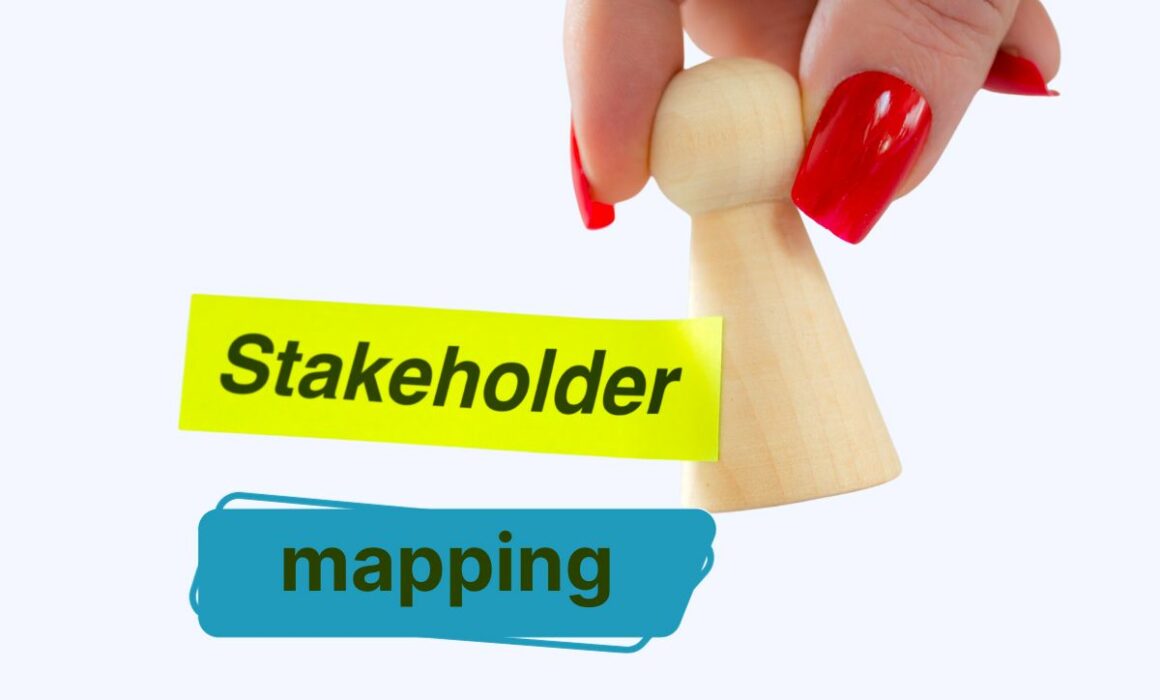How Does Stakeholder Mapping Work: A Product Manager’s Guide
Stakeholder mapping is a valuable stakeholder analysis process that can help project managers understand what drives their stakeholders. More importantly, it allows product managers to implement ways to communicate with them properly.
According to the Project Management Institute (PMI), inadequate communication plays a significant role in project failure one-third of the time. Even worse, it can hinder a project’s success over half the time. Product managers can’t risk product failure because of poor communication with project stakeholders.
Because of this, they’ll need to understand how to communicate and engage with these important contributors effectively.
Table of Contents
- Why is stakeholder mapping important?
- When to use a stakeholder map?
- What are the types of stakeholders?
- How do you map the relationships between stakeholders?
- How to prioritise stakeholders
- How to create a stakeholder map
- Benefits of stakeholder mapping
- Stakeholder mapping models
- Some considerations when using common stakeholder mapping models
- Stakeholder Mapping Templates
- Stakeholder mapping best practices
- Product managers must master stakeholder mapping
- Machine Learning In Finance: 12 Essential Applications
- How To Create Interactive Compliance Training For Bank Employees
- How Fintech Apps Are Using Gamification To Increase User Engagement
- Top Gamification Companies for Employee & Customer Engagement
Depending on your project, your list of project stakeholders might include clients, collaborators, project owners, or even end-users. Ultimately, stakeholder mapping makes communication with them a lot easier.
Why is stakeholder mapping important?
Stakeholder mapping is a process in stakeholder management that aims to identify the existing and potential stakeholders. Once you know the important people involved, you can further understand them and fulfil their interests, needs, and expectations. This stakeholder analysis process exists to make it easier for product managers to communicate with stakeholders and keep them happy.
More importantly, the insights gained from building solid ties with them are invaluable for the product’s success. Through stakeholder mapping, you can leverage the data from stakeholders to build a new product, penetrate a market, or even start a new project. It’s crucial to form a communication plan that will benefit both your team and the cross-functional teams involved.
Ultimately, it can aid you in understanding where both internal and external stakeholders stand regarding the project. And once you do, managing their expectations and keeping them satisfied will be ten times easier.
Coca-Cola’s impressive stakeholder engagement
Coca-Cola didn’t just become successful because of their products but also because of how it engages with its stakeholders. Without a comprehensive stakeholder map, they wouldn’t have identified the people rooting for their success, like bottling partners and investors. As a result, their collaboration with these important stakeholder groups has been highly beneficial both for them and the company.

When to use a stakeholder map?
Having a way to identify all internal and external stakeholders involved in a project is a tremendous advantage. You can utilise this process in various scenarios, such as:
- Project kickoff
- Product launch
- Change in management
- Issue resolution
- Continuous feedback
- Prioritisation
- And more.
What are the types of stakeholders?
Project management requires the involvement of experts from different teams who have shared their vote of confidence in your product. To further understand these individuals, product people have divided them into different categories, namely:
- Primary stakeholders are the individuals or groups directly affected by or with significant influence over your product.
- Secondary stakeholders are those interested in your product but have less direct influence.
- Internal stakeholders – Internal stakeholders, individuals or teams within your organisation directly involved in or impacted by your product.
- External stakeholders – External stakeholders are individuals or groups outside your organisation interested in your product.
- Direct stakeholders – These people are closely connected to your product and have a clear and immediate impact.
- Indirect stakeholders are individuals or groups with a more distant or indirect connection to your product, which may be affected by your product’s actions or decisions.
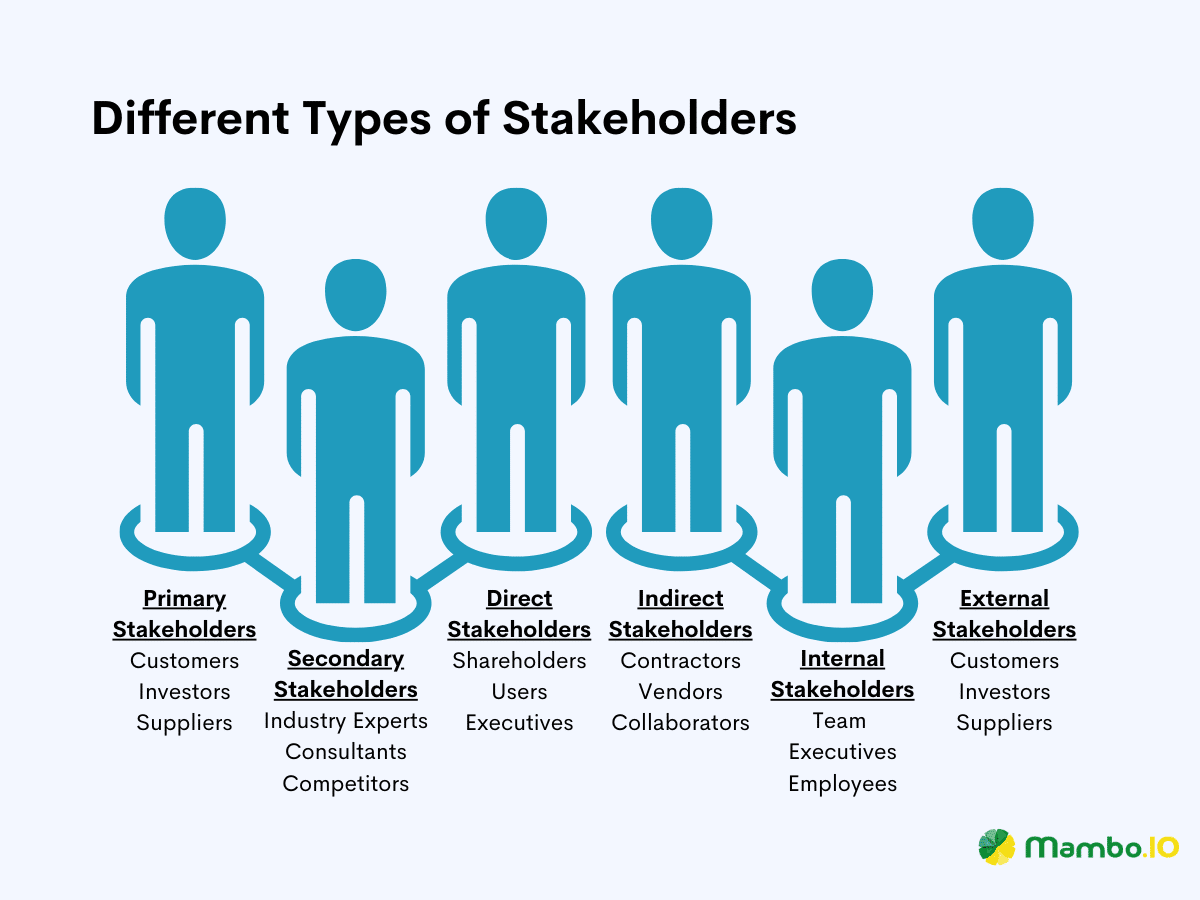
How do you map the relationships between stakeholders?
You can start mapping stakeholder relations once you finish the stakeholder identification process. Every organisation will have different requirements, so you must tailor your approach to your company’s specific needs.
To build a stakeholder map, you’ll need three essential things, mainly:
- Your stakeholders
- A framework to work with
- An assessment criteria
These are just the essential components to map the relationships between stakeholders. Feel free to add any important information relevant to the project.

Next, you’ll need to choose the framework to use. You can use a grid or a network diagram, depending on how many people you’ll need to plot.
Grid stakeholder map
A grid map lets you view the people involved in the project and their relationships at just a glance. This framework is ideal for large companies dealing with major projects that involve many stakeholders. And when used correctly, it can give an overview of the stakeholders based on their level of interest and influence.

Network diagram
If you’re working with a relatively small company involving fewer stakeholders, using a network diagram is recommended. It details the interactions between stakeholders and how changes can affect them as the project progresses.

How to prioritise stakeholders
You’ll quickly realise that some stakeholders are much more impactful than others. Moreover, some will express more interest in the product’s success. As a project manager, it’s your duty to know which of them deserves more time, resources, and attention. Once you’ve prioritised them, you can establish a communication plan.
Four levels of stakeholder involvement for stakeholder mapping
So, how do you prioritise your stakeholders? You can start doing so by mapping them using a simple stakeholder matrix like the one shown below. With this stakeholder matrix, you can organise them based on their power over your project and interest in seeing your product succeed.
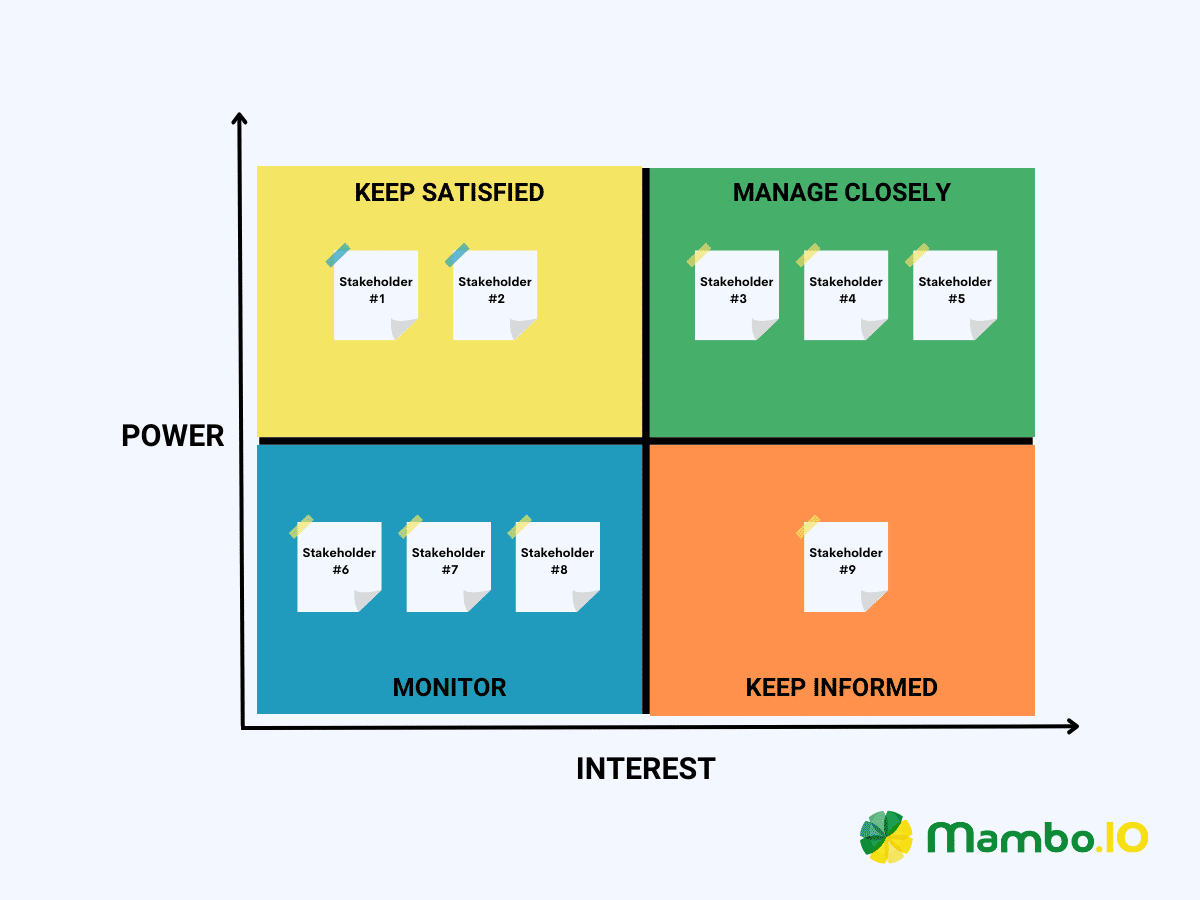
Ultimately, the stakeholder involvement will fall into four different levels:
- High power, high interest (manage closely) – These “key stakeholders” significantly impact your product and are vested in its success.
- High power, less interested (keep satisfied) – They may not wield much influence but are keenly interested in your product’s outcomes.
- Low power, high interest (keep informed) – They have the power to affect your product but may not be deeply interested.
- Low power, less interested (monitor) – They have limited impact and interest.
How to create a stakeholder map
#1. Define the purpose of the stakeholder map
Before creating a stakeholder map, you’ll need to understand why you have to make one in the first place. Are you planning to develop a new software? Or do you want to adjust accordingly during organisational changes?
Regardless of your reason, always remember that a stakeholder map exists to align stakeholders and manage their expectations. Once your idea behind mapping these people is crystal clear, you can start hopping on to the next steps.
#2. Identify your stakeholders
Identifying your stakeholders is a critical early step in managing a product’s lifecycle. There are many ways to do this, like referring to documents like the project charter. However, brainstorming remains the most effective proven-and-tested way to do so. Collaborate with your team, create an exhaustive list of stakeholders and consider anyone interested in your product.
These people can be anyone who might have a vested interest in your product. More importantly, don’t exclude anyone at this stage and pay extra attention to detail to account for all relevant stakeholders.
Your list of stakeholders will largely depend on your organisation, the impact of the product, and its objectives. This list is constantly changing, so prepare to update it occasionally.
#3. Determine their level of involvement
After listing your stakeholders, your next step is to assess their level of involvement at various project stages. This is the part where the four levels of stakeholder involvement we’ve discussed earlier prove useful.
Additionally, the nature of your project may alter the people involved. In some cases, high-involvement stakeholders are from outside your organisation, while low-involvement stakeholders could even include your colleagues.
#4. Analyse and categorise your stakeholders
Once you’ve identified your stakeholders, you should analyse them by understanding their interests, goals, concerns, and potential conflicts.
What will they gain from the success of your product?
Having a deeper understanding of these people allows you to tailor your stakeholder strategies and meet their needs and expectations. It will also help identify competing priorities between stakeholders so you can proactively address potential conflicts head-on.
Afterwards, categorise them based on influence (power capacity) and interest. Always prioritise key players with the highest influence or interest since they can affect the project’s progress the most. Once you’re done categorising your stakeholders, you can formulate a plan to engage each of them effectively.
#5. Develop an effective engagement plan
With everything set in place, your final step is to create a stakeholder engagement strategy. A project manager like you must recognise that each stakeholder has different communication needs. Therefore, it’s up to you to interact with them to keep meeting both their requirements and expectations.
Below are some questions you may consider when tailoring an effective engagement plan for your stakeholders.
- How do they prefer to communicate?
- What information do they need?
- How will you gather feedback from them?
- Are there any contingency plans in place in case things go south?
- What are the milestones and touchpoints for this engagement plan?
Benefits of stakeholder mapping
#1. Increased stakeholder engagement
Stakeholder mapping allows product managers to pinpoint individuals and groups heavily interested in your product. If you understand their needs, concerns, and motivations, you can find ways to communicate and engage with them effectively. Such a targeted approach eventually leads to stronger relationships with stakeholders. Moreover, it ensures they are active participants in your endeavours and committed to your product’s success.
#2. Risk mitigation
Stakeholder mapping exists to help product managers identify and mitigate potential risks early in the development process.
The behaviours and decisions made by some stakeholders will inevitably be a risk to your project at some point. With the knowledge of posing challenges and opposition, you can proactively address your stakeholder’s concerns and other roadblocks. This foresight is invaluable if you want to avoid costly delays and setbacks.
#3. Efficient resource allocation
Product managers often juggle limited resources, so they must prioritise efficient resource allocation. With stakeholder mapping, you can allocate resources to your stakeholders strategically. Since you know who’s the most impactful stakeholders, you can prioritise your efforts and resources accordingly. By doing so, you can optimise your product’s development trajectory.
#4. Clear accountability
Accountability must be present when working with people, even outside product and project management. Stakeholder mapping ensures all roles and responsibilities of each stakeholder are clear. More importantly, it emphasises that they understand how to contribute to the product’s objectives. This level of transparency is necessary to foster trust within cross-functional stakeholder groups and to avoid micromanagement.
#5. A solid and actionable plan
The primary purpose of stakeholder mapping is to act as a solid and actionable plan for engaging with stakeholders. It primarily gives you a comprehensive understanding of their expectations and requirements.
Armed with this knowledge, you can develop strategies and roadmaps that align with your product’s goals. Such a plan can serve as a north star throughout the product development lifecycle to keep your team on track.
Stakeholder mapping models
Stakeholder mapping spreadsheets
Stakeholder mapping spreadsheets are practical tools for organising and managing stakeholder data efficiently. As the name suggests, it uses spreadsheets to store important information such as names, roles, interests, concerns, power, and more. This is a viable way to provide structure when prioritising engagement and accessing critical information.
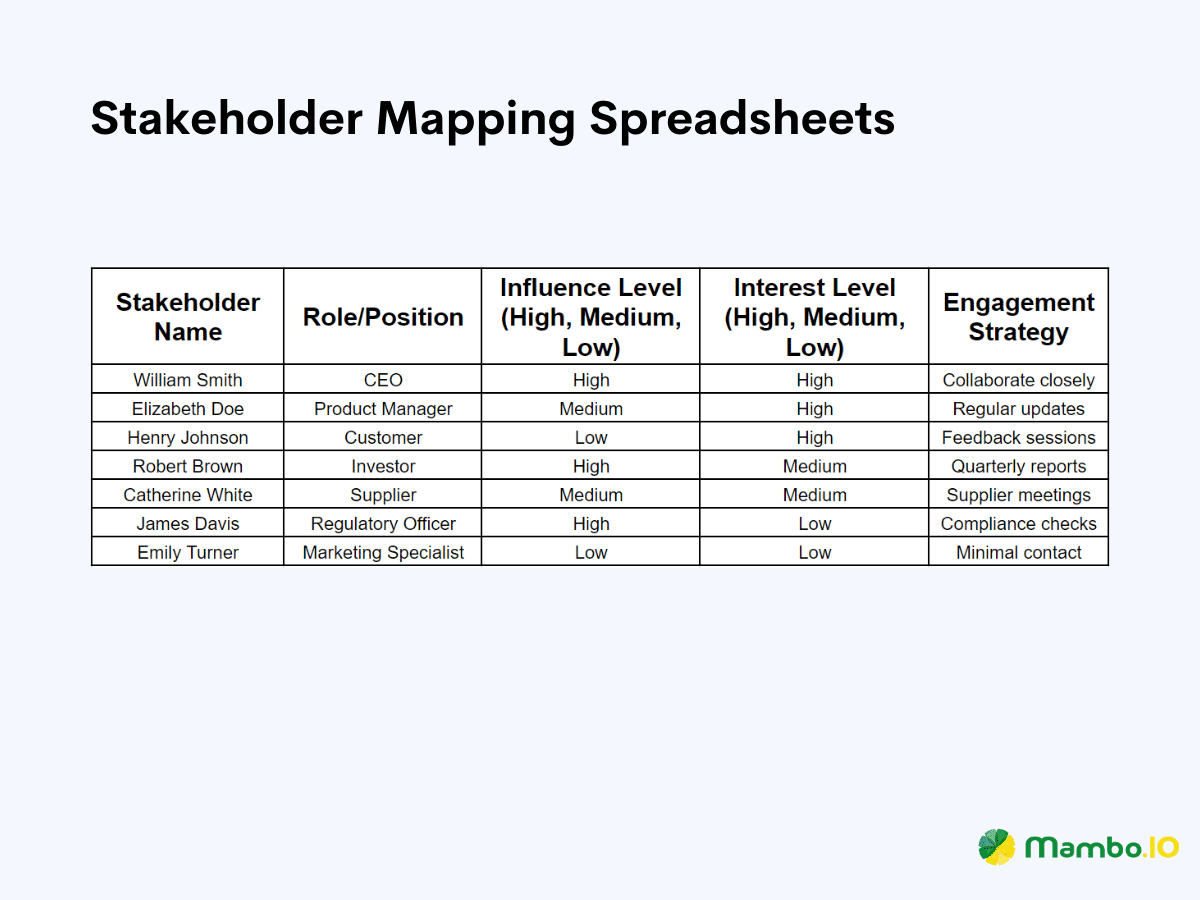
Salience model
Product managers use the Salience Model to categorise stakeholders based on three essential factors: power, legitimacy, and urgency.
Salience means how much priority product managers should give to stakeholders. If the stakeholder has more power, urgency, and legitimacy, they have higher salience. Here’s what those three factors mean:
- Power – This is the stakeholder’s ability to influence the product or organisation.
- Urgency – It refers to how quickly a stakeholder needs a response to their requests.
- Legitimacy – This relates to the stakeholder’s right to be involved and their relationships with their organisation.

Stakeholder knowledge base chart
The stakeholder knowledge base chart helps product managers understand their stakeholder information, such as goals, interests, and concerns. Further understanding of this information allows product managers to customise their communication and engagement strategies with stakeholders.
This chart divides stakeholders into four quadrants based on their awareness and attitude towards the project:
- Aware/Opposition – Stakeholders who are informed but have opposing views require careful management.
- Aware/Support – Informed stakeholders who support the project are valuable for advocacy.
- Ignorant/Opposition – Uninformed stakeholders with an opposing view and potential to change through increased understanding.
- Ignorant/Support – Uninformed stakeholders who can be engaged to gain their support and strengthen it.

Power/Interest matrix
The Power/Interest grid categorises stakeholders into four quadrants based on their power (influence) and interest (concern) with the product. These quadrants dictate different stakeholder engagement strategies:
- High power/high interest
- High power/low interest
- Low power/low interest
- Low power/high interest
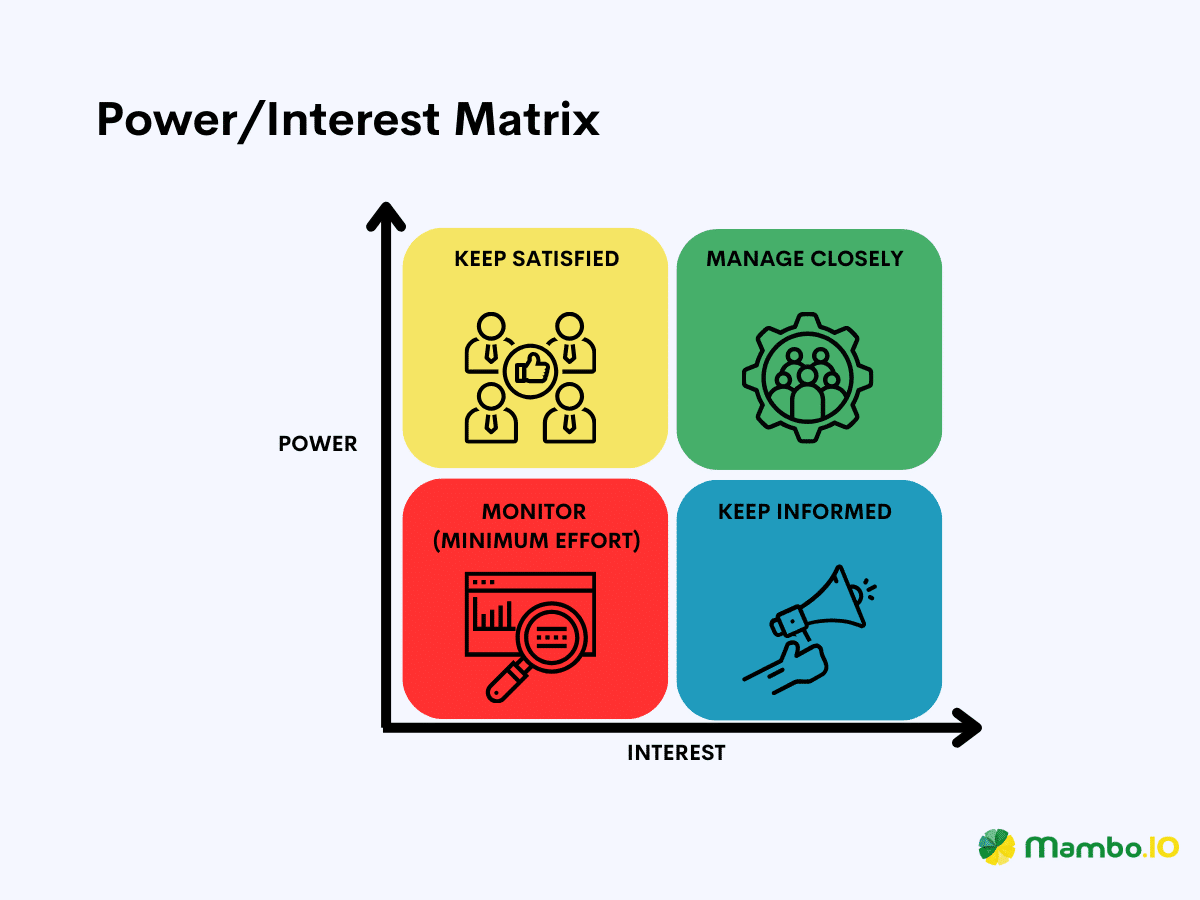
This model suggests that product managers should engage the stakeholders depending on their position in the quadrant, either more frequently or less frequently.
Power-predictability matrix
The Power/Predictability matrix assesses stakeholders based on their power and predictability. It’s an adaptation of the Power/Interest matrix that helps identify the level of challenge each stakeholder poses.
Here’s the breakdown of each quadrant present in this matrix:
- High predictability & low power – Manageable issues, like predictable regulations.
- Low predictability & low power – Unpredictable issues, often not project-threatening.
- High predictability & high power – Manageable challenges due to predictability, like strict regulations.
- Low predictability & high power – Most challenging stakeholders, requiring careful handling and opportunity for improvement.
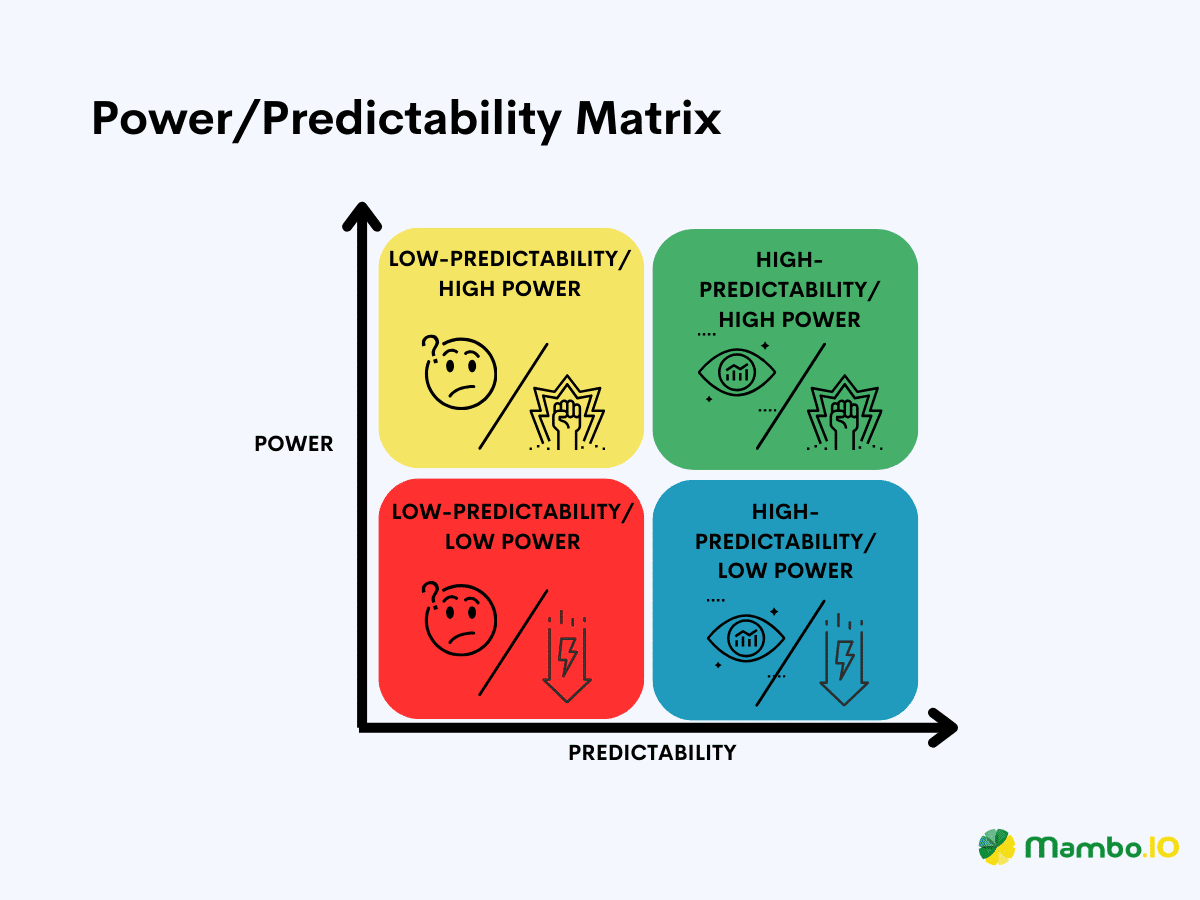
Stakeholder relationship mapping
Stakeholder relationship mapping helps visually represent and analyse the connections between stakeholders. It further displays the strength of relationships, influence levels, and other attributes to understand the dynamics between potential stakeholder groupings.
This model allows product managers to uncover alliances, conflicts, and dependencies within the stakeholder network. The interwoven connections between these people are goldmines for valuable insights into decision-making and communication strategies.

Some considerations when using common stakeholder mapping models
Stakeholder management and public participation have evolved significantly in recent decades. Unfortunately, the models we use today haven’t kept pace, many dating back three decades or more. As product managers, you must learn how to adjust your approach when employing these models to achieve favourable outcomes.
Here are some key considerations you need to think about when using stakeholder mapping models.
Power dynamics have changed
Power dynamics in the business landscape have undergone a significant transformation in the past few decades. They’ve shifted from rigid hierarchies into a more fluid yet rapidly evolving structure. As a project manager, you must adapt to these ever-changing power dynamics when creating stakeholder maps.
Stakeholders tend to place great expectations
Stakeholders nowadays expect a more active role in decision-making, even if they’re less impactful than necessary. Most of the time, they demand regular updates on project progress and will wait attentively for opportunities to express their concerns. With this in mind, you must manage their expectations so nobody will feel frustrated when things go south.
The languages used in stakeholder models need updating
The language used to describe stakeholders in the past might not apply to today’s standards. Some once-acceptable terms used in stakeholder mapping may now be deemed offensive. Because of this, you’ll need to choose your words carefully when creating stakeholder models.
Use stakeholder maps to convey value
Many product managers create stakeholder maps with good intentions. However, these documents tend to become aesthetically pleasing reports that no one will care about later. That’s because these models often lack the depth and information needed to influence product development.
With this in mind, product managers are urged to create models that provide valuable insights throughout the product lifecycle. Make it a resource the project team members can reliably refer to when collaborating with stakeholders.
Stakeholder Mapping Templates
Below are some of the best templates to streamline your stakeholder mapping process.
#1. Miro
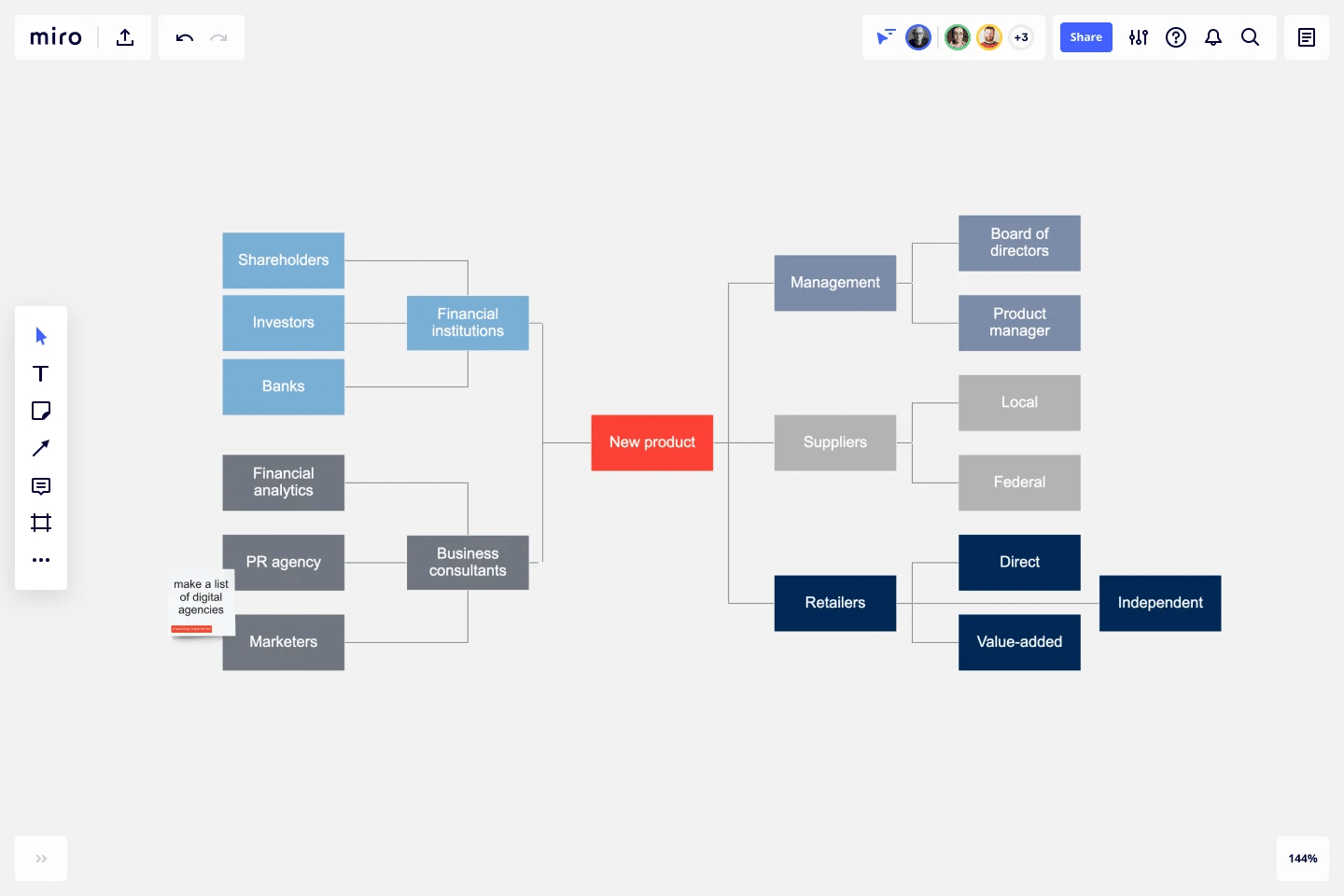
Source: Miro
Miro offers some of today’s most straightforward yet intuitive stakeholder mapping templates. With Miro, you can utilise their infinite canvas and collaborate with your project team to map stakeholders. It is the ideal software for stakeholder brainstorming sessions with your team.
#2. Mural
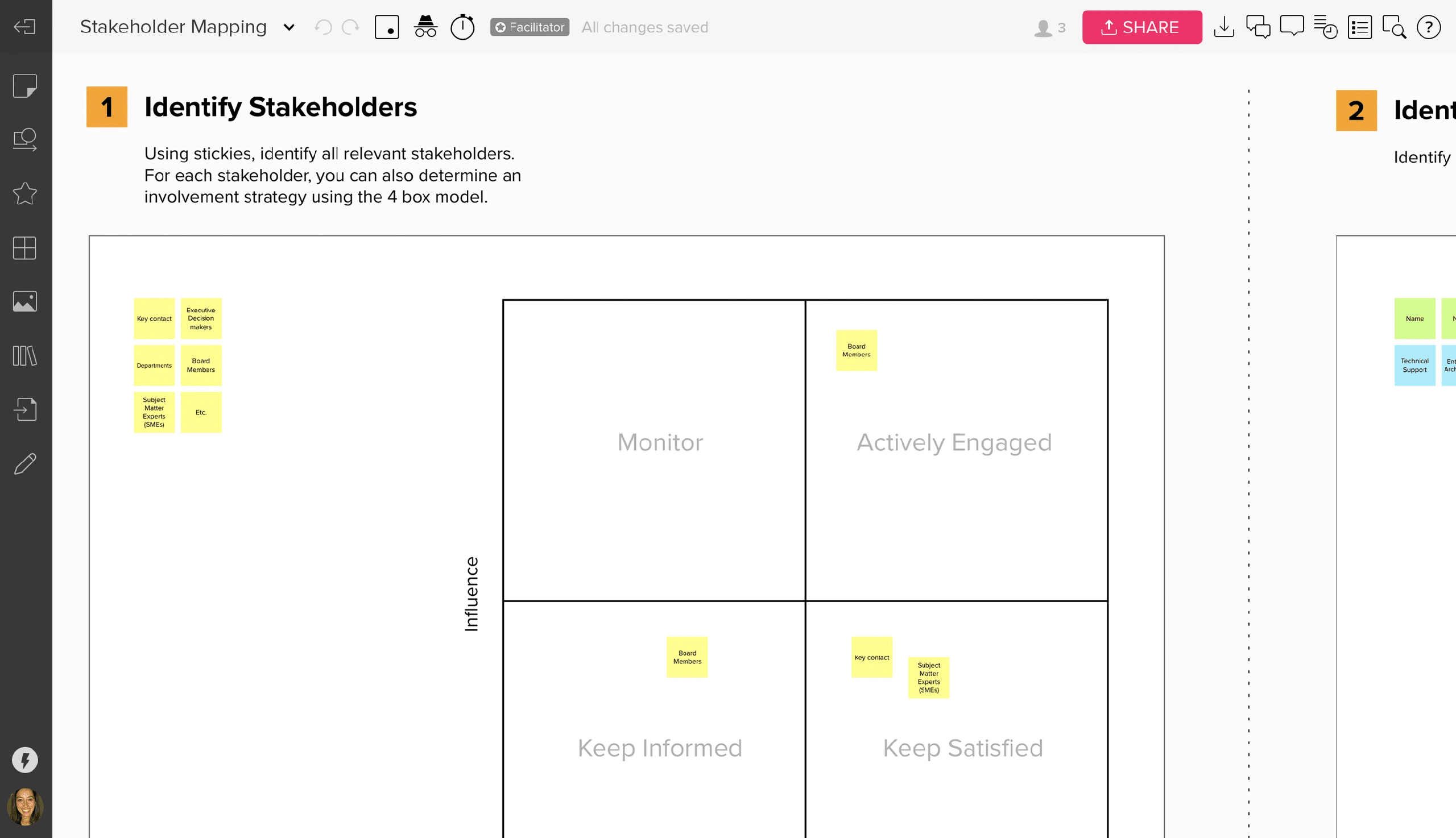
Source: Mural
You can use Mural’s Power/Interest grid to understand the key stakeholders in your product development lifecycle. It has a suite of features that allow seamless stakeholder mapping and collaboration, such as real-time collaboration, commenting, and more.
#3. Lucidchart
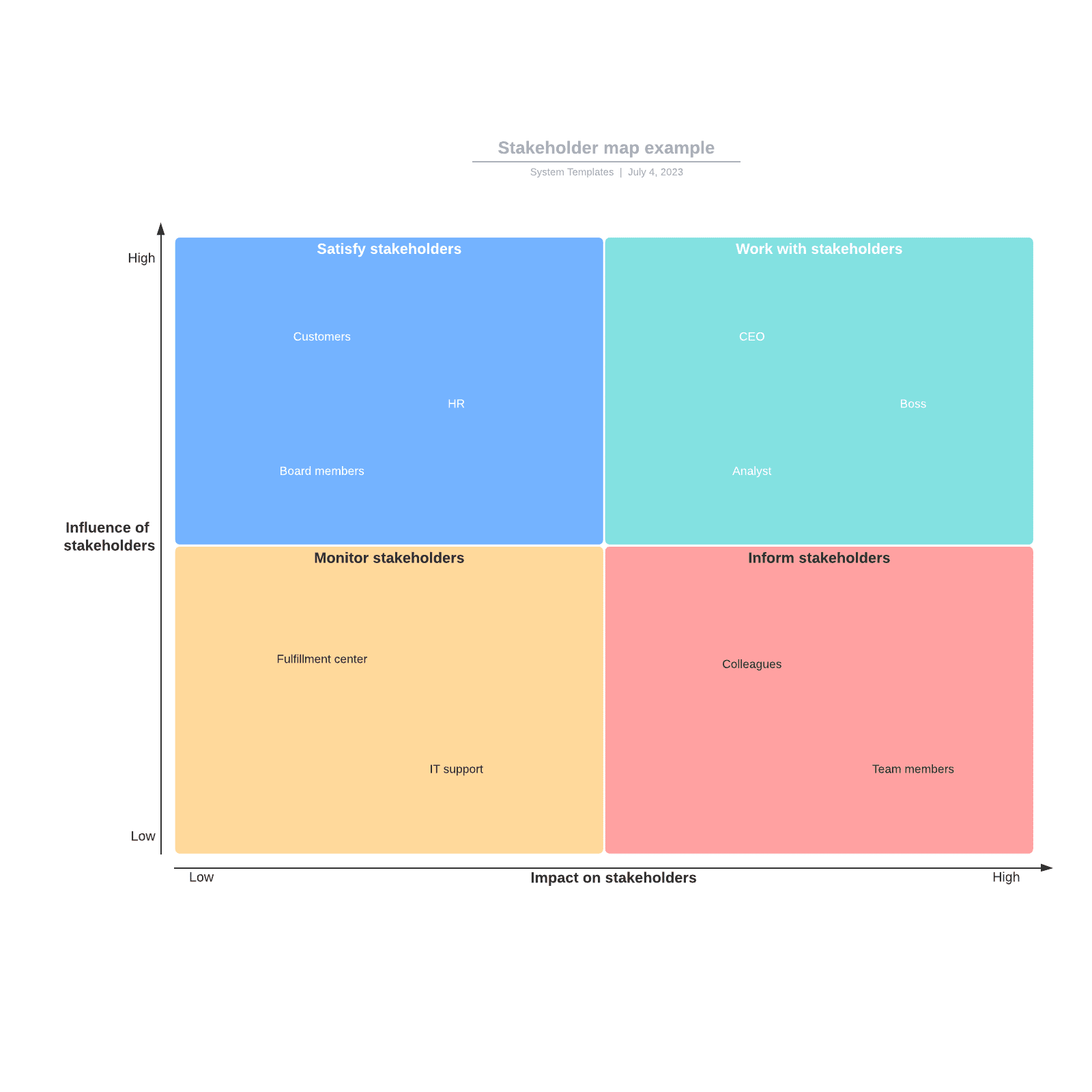
Source: Lucidchart
Lucidchart is one of the go-to resources of product managers when it comes to mapping stakeholders. They offer a stakeholder map template that lets you understand everything you need to know about your stakeholders. Lucidchart empowers you to visualise intricate project management concepts swiftly, with greater clarity, and through seamless collaboration.
Stakeholder mapping best practices
Understanding how to create stakeholder maps and implementing them correctly are two different things. The world of product and project management is dynamic, so you must adjust accordingly to achieve the best outcomes. Let’s look at the best practices you can follow to ensure your stakeholder maps are valuable and insightful.
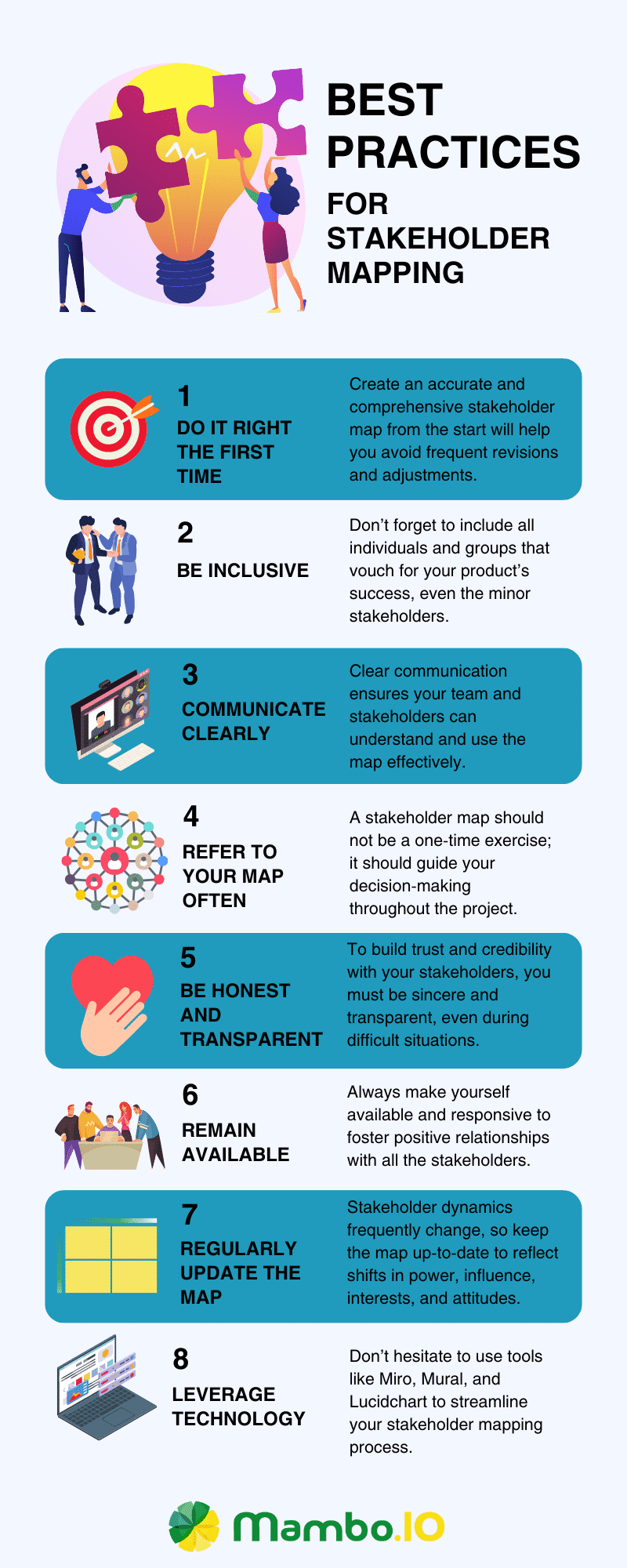
Product managers must master stakeholder mapping
Stakeholder mapping is indeed an impressive stakeholder analysis tool. It allows product managers like you to understand everything relevant about the stakeholders and their involvement with the project.
As a product manager, you can use this stakeholder analysis process effectively to your team and organisation’s advantage. Once you’ve mastered stakeholder mapping, you can easily distinguish the best way to communicate and engage with your stakeholders.
At Mambo.io, we strive to equip product managers with everything they need to succeed. That’s why we are eager to provide you with extensive resources to improve your skills as a product manager. Browse our resource tab and learn how to be the best product manager you can be!
Download your free
“Gamification Guide”
Get your PDF now and start transforming your approach to digital engagement!
Latest Posts
Machine Learning In Finance: 12 Essential Applications
The impact of machine learning on finance is significant. Thanks to this technology, financial institutions are now equipped to make efficient decisions. Through the analysis of data sets, machine learning […]
How To Create Interactive Compliance Training For Bank Employees
Banking compliance training isn’t just another task. It’s the stage where everything else performs. Banks must navigate a myriad of regulations and laws. After all, this is a trust-driven, high-stakes […]
How Fintech Apps Are Using Gamification To Increase User Engagement
Discover how gamification in fintech is revolutionizing financial engagement, making banking fun & boosting user loyalty.
